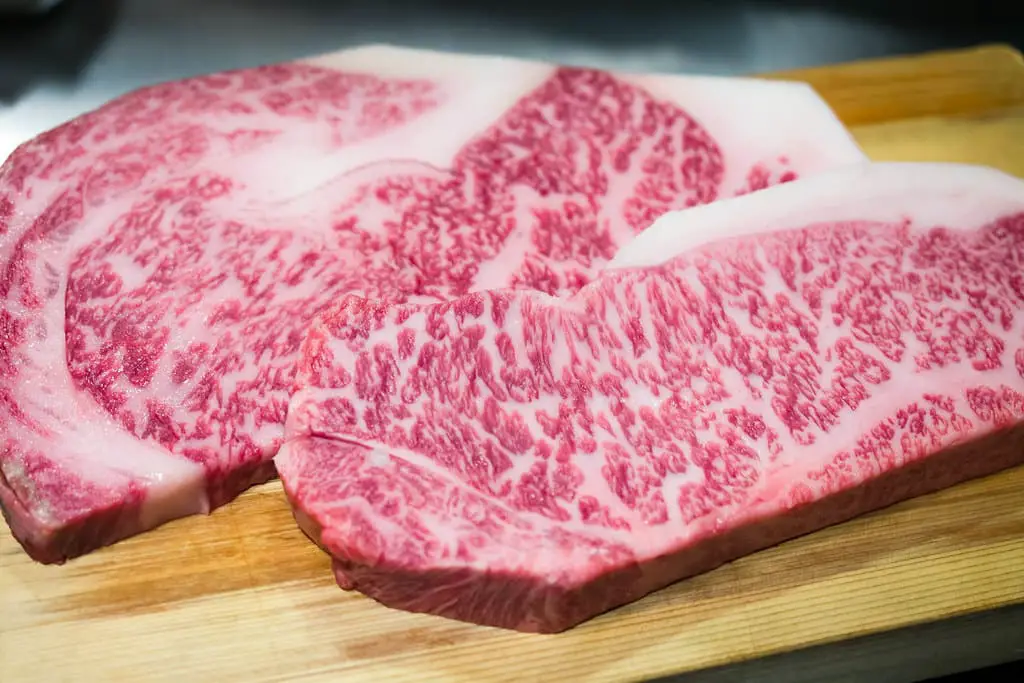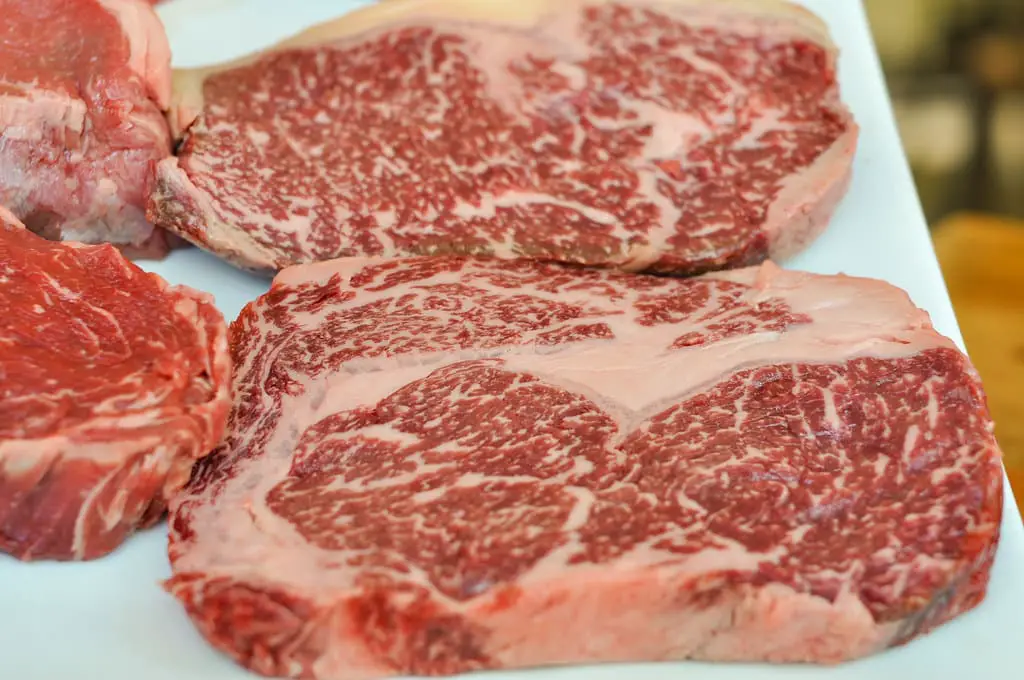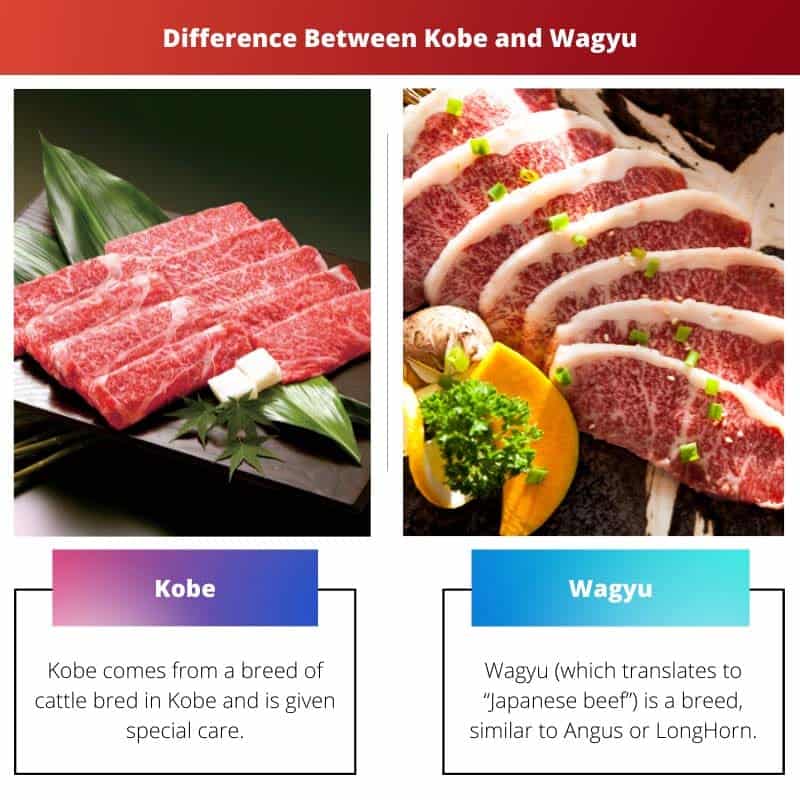The option of which sort of beef to ingest is not easy for meat-eaters. Various goods have been produced in an attempt to meet people’s requirements as their preferences for many items have changed.
Though many of us haven’t tasted beef, we’re all familiar with the moniker. Many restaurants and chefs across the world are ready to spend a top price to make and serve it since the brand is synonymous with gourmet excellence.
Some of the top-quality kinds of beef are Kobe and Wagyu.
Key Takeaways
- Kobe beef comes from Tajima-gyu cattle raised in Kobe, Japan, while Wagyu beef comes from any of the four Japanese cattle breeds.
- Kobe beef has a higher fat content and is known for its tenderness and flavor, while Wagyu beef is known for its marbling and rich taste.
- Kobe beef is rarer and more expensive than Wagyu beef.
Kobe vs Wagyu
Kobe beef is a type of Wagyu beef gotten from the Tajima strain of Japanese Black cattle. It meets the rules of the Kobe Beef Marketing and Distribution Promotion Association. Wagyu beef is used to define a collective name for the four main Japanese breeds of beef cattle and is exported to the UK, USA, and Australia.

Kobe beef is a delicacy because of its flavor, tenderness, and fatty, well-marbled texture. Along with Matsusaka beef and mi meat or Yonezawa beef, Kobe beef is widely regarded as one of the three top brands.
Kobe beef has many more options like Steak sukiyaki, shabu-shabu, sushi, and teppanyaki.
The name wagyu is a combination of the words “we” and “gyu,” which means “Japanese” and “cow,” respectively.
This selection favored animals with a higher number of intramuscular fat cells (‘marbling’), which offered a readily available energy source. Wagyu cattle possess horns and can be black or red.
Comparison Table
| Parameters of Comparison | Kobe | Wagyu |
|---|---|---|
| Definition | Kobe comes from a breed of cattle bred in Kobe and is given special care. | Wagyu (which translates to “Japanese beef”) is a breed similar to Angus or LongHorn. |
| Pricing | High | Moderate |
| Grading standards | It has to be in a perfect texture, firmness, measurements, and quality should be great. | Do not have stringent measures in place. |
| Nutritional value | s rare and well-marbled, making it one of the healthiest cuts of red meat available. | Wagyu beef contains a greater ratio of monounsaturated fats, omega-3, and omega-6 fatty acids and is lower in cholesterol than ordinary beef. |
| Distribution | It is a registered trademark of the Kobe Beef Marketing and Distribution Promotion Association. | Exported to the U.K., Australia, U.S.A, and crossbred and distributed there by various breed associations. |
What is Kobe?
A precise set of requirements must be satisfied for beef to be labeled as Kobe. First and foremost, it must be descended from one of the government’s 12 idealistic bulls and must originate from Tajima cattle, a type of Japanese Black.
Hyogo prefecture is also where the calves must be born, nourished, and processed. It must also be nourished for at least 26 months to attain a gross weight of 1,036 pounds of generated meat but no more.
As a result, the supply is reduced in many ways, but the demand stays the same.
At legally authorized slaughterhouses, the cows are slaughtered. The meat is next evaluated and measured in every possible manner.
Simply the finest quality meat will be certified as Kobe, and each piece of beef will be stamped with an official seal and identification number that can be used to trace a piece of beef back to its source!
The Tajima is a subspecies of the Japanese Black, which is the most common breed in Japan (around 90 percent of the four breeds).
Till World War II, beef consumption remained low. In the 1980s and 1990s, Kobe beef gained appeal and, from then, expanded its worldwide reach.

What is Wagyu?
The name wagyu is a combination of the words “we” and “gyu,” which means “Japanese” and “cow,” respectively. However, this event does not imply that any Japanese cow is illegible.
Because so much emphasis is placed on genetics, the beef becomes genetically predisposed to be of greater quality than most steaks, and this tender, well-marbled beef truly outperforms the competition.
This selection favored animals with a higher number of intramuscular fat cells (‘marbling’), which offered a readily available energy source. Wagyu cattle are horned and can be either black or red.
First and foremost, all Kobe is Wagyu, yet only a small percentage of Wagyu is Kobe.
The reason for this is straightforward: Wagyu refers to Japanese cows of the Black, Brown, Shorthorn, and Polled genotypes, which are genetically inclined to store fat in muscular tissue.
All four were designated national treasures and prohibited from being exported until 1997.
Just because it has that label does not imply that it is of comparable quality. Breeders will frequently muddy their lineages for toughness and profitability by cross-breeding Wagyu cattle with more common kinds.
“Over 95 percent of Australian Wagyu cattle are crossbred with other breeds,” says Kimio Osawa, a Japanese beef specialist and founder of wholesale supplier Osawa Enterprises.

Main Differences Between Kobe and Wagyu
- To be Kobe beef, it has to be in a perfect texture, firmness, measurements, and quality should be great, while Wagyu does not have stringent measures in place.
- Kobe comes from a breed of cattle bred in Kobe and given special care, and Wagyu is a breed similar to Angus or Long Horn.
- Kobe is highly priced and rare, whereas Wagyu is priced moderately.
- Kobe is one of the healthiest cuts of red meat since it’s rare and well-marbled. Wagyu beef is lower in cholesterol and has a higher ratio of monounsaturated fats, omega-3, and omega-6 fatty acids than regular beef.
- Kobe is a trademark of the Kobe Beef Marketing and Distribution Promotion Association, and Wagyu is exported to the United Kingdom, Australia, and the United States of America, where it is crossbred and sold by several breed associations.




